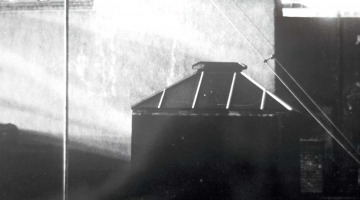When I enter group shows I like to take a collective read of the work before I read the curatorial statement, because it is important to me to question the resonance of the work outside of its intended grouping. Overall, the formal qualities of the work rated high on the making scale and resonated alternate reads beyond their original curatorial intention for being put together.
I felt a sense of gentle foreboding throughout the exhibition, whether it was in response to the death and mortem of “the academy” and fine art itself, or from a place that reminded me I was standing in the company of objects in a Victorian parlor awaiting a funereal ceremony – from romantic tales, to the paintings on the mantel and the urn awaiting the ashes of the pending remains.
Of particular consideration is the video “Valley of the Deer” by Jillian McDonald in the dark viewing room. This fantastic non-linear story is a collection of moving portraiture vignettes that situates the viewer in a diorama of lush pastoral scenes with characters playing the roles of hauntingly beautiful creatures, languid beauties and creepy or curious gents. Many of the scenes have a very small depth of field with blurred edges that lends a toy-like scale creating a miniature puppet theater effect. The characters do ominous things, such as stand at attention/warning with scythes, or softly swing their arms back and forth in quaint, lollygagging gestures. There is no dialog or captioning for this film, so the mind is left to wander…except when ambient female vocals sway in and out of notice. This was an unnecessary layer to the already compelling visuals that would have served well with no indication of a wistfully mute narrator, as the vocals imply. Still, the beautiful imagery and the quirky pacing kept me watching.

Anthony Discenza,
The Visage (foreground object pictured). 2012
Inkjet on found paper, 7″ x 4″. Courtesy of Queen’s Nails

Michelle Blade, Black Hole Funeral Wreath, 2013. 36″ x 60″ (variable installation).
Courtesy of Queen’s Nails
Back in the front room of the gallery, Anthony Discenza’s fictitious pages of books are lovely and delicate – each one poignant and cryptic, albeit somewhat kitsch in their poetic mannerism. The text comprised of Discenza’s own writing reads like the lonely darkness of late nineteenth and early twentieth century romantic horror novellas. They remind me of pages torn from the gilt binding of cloth-covered novels in a Victorian parlor and complimented Michelle Blade’s “Black Hole: Funeral Wreaths” that are situated prominently, also in the front gallery.

Valerie Hegarty, George Washington Melted 4, 2011. 40 x 30 inches. Canvas, stretcher, paper, acrylic paint, gel medium.
Courtesy of Nicelle Beauchene Gallery, New York.
Further parlor references came to mind when viewing Blade’s large urn on display in the back of the gallery, which contains the ashes of her burned paintings. I thought that her two pieces related nicely, but I wondered why the urn was made so rustically and not more like a pristine replication of a real funeral urn. Next to it is Valerie Hegarty’s “George Washington Melted 4” which melts in apocalyptic grandeur. The urn reads more like an early American folk-jug and makes the link between the “deaths” of art quite obvious. Taking the meta-concept of formal-art-practice-meets-doom further, George Pfau’s photographs of tiny zombie figures in his paintings are enlarged beyond the indiscernible and become human-scale photographic studies of the paint itself.
There lies the rub of the narrative within a group show and the curatorial process to hang the works cohesively. The work is linked throughout the show in a non-linear manner, which disperses the formal undertones yet compliments the uncertainty of its destructive subject matter .
For more information visit Queens Nails Gallery.
-Contributed by Leora Lutz




